| Author |
Topic: Control by Cable-within-Tube |
Alan Brookes
From:
Brummy living in Southern California
|
 Posted 17 Feb 2008 8:58 pm
Posted 17 Feb 2008 8:58 pm |
|
Everyone is familiar with cable instruments, such as the Fenders, MultiKords, etc., but they all operate with the cable under tension, pulling on the mechanism.
Now imagine the cable of a car accelerator, and a camera's external shutter-release cable. They have cables within a tube. The advantage is that they don't need to be at constant tension. They can be coiled into any shape and still work. The reason is that the pressure is applied by the motion of the internal cable moving against the secured tube.
A pedal steel guitar built with such cables would need very little set-up time. You could even separate the pedal frame from the instrument, allowing a simple mechanism on a resonator guitar, for instance, or you could put a mechanism on a regular guitar.
Added 23Jun2011:
I'm resuscitating this thread because I'm about to start work on a converted MultiKord. See my latest comments.  Any ideas ? Any ideas ?
Last edited by Alan Brookes on 23 Jun 2011 1:42 pm; edited 1 time in total |
|
|
 |
richard burton
From:
Britain
|
 Posted 17 Feb 2008 10:19 pm
Posted 17 Feb 2008 10:19 pm |
|
That's exactly how I built my first few steels.
This one here is a very early one, with the cables external.
I modified the design, and had all the (Bowden?) cables 'under the hood' on subsequent steels.

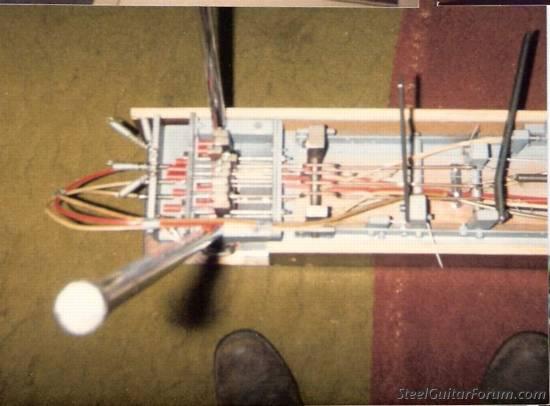
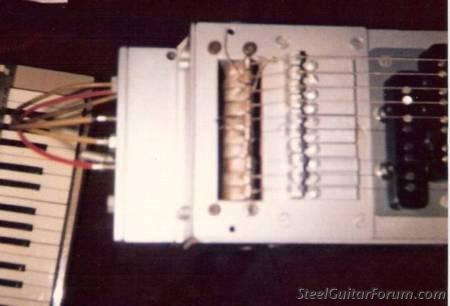 |
|
|
 |
Brint Hannay
From:
Maryland, USA
|
 Posted 17 Feb 2008 11:08 pm
Posted 17 Feb 2008 11:08 pm |
|
I may be mistaken, because I never have seen one "in the flesh", but I believe that's how the Pedal Pitch device for guitar made by MSA in the Seventies, and most notably used by Phil Baugh, worked.
http://www.youtube.com/watch?v=ZX6J0mgX4bc |
|
|
 |
Eddie Cunningham
From:
Massachusetts, USA
|
 Posted 18 Feb 2008 8:40 am Bicycle hand brake cable/tube
Posted 18 Feb 2008 8:40 am Bicycle hand brake cable/tube |
|
| I made one for a lap steel once using a bycycle hand brake cable/tube to lower one string and it worked out fine !! Is a simple basic operation . Maybe it just doesn't look as neat as straight rods ?? but it does work !! Eddie "C" ( the old non-pedal geezer ) |
|
|
 |
James Collett
From:
San Dimas, CA
|
 Posted 18 Feb 2008 9:55 am
Posted 18 Feb 2008 9:55 am |
|
Seems like it would make more sense- no more annoying rattling, etc. of the undercarriage, and to change your copedent, just unscrew the tube and slide it on over! The only problem I foresee is on pedals with more than 1 change.
_________________
James Collett |
|
|
 |
Darvin Willhoite
From:
Roxton, Tx. USA
|
 Posted 18 Feb 2008 6:43 pm
Posted 18 Feb 2008 6:43 pm |
|
Here's pictures of my pedal device for a six string. I don't think this one was made by MSA, it looks quite different from Phil Baugh's. I've heard that Dekley may have made this one. Back to the original question, the cable action is very spongy, due to the cables stretching slightly. Once you get used to it it isn't too bad, but I would much rather have a positive, mechanical linkage like most steels.
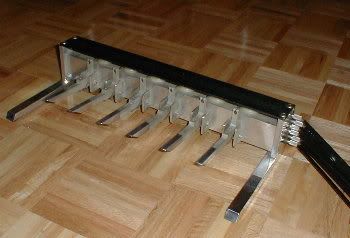
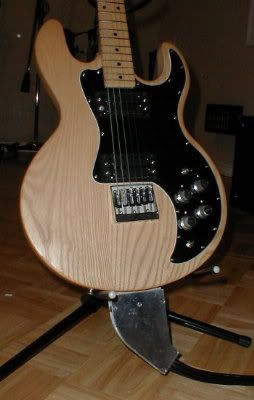
_________________
Darvin Willhoite
MSA Millennium, Legend, and Studio Pro, Reese's restored Universal Direction guitar, a restored MSA Classic SS, several amps, new and old, and a Kemper Powerhead that I am really liking. Also a Zum D10, a Mullen RP, and a restored Rose S10, named the "Blue Bird". Also, I have acquired and restored the plexiglass D10 MSA Classic that was built as a demo in the early '70s. I also have a '74 lacquer P/P, with wood necks, and a showroom condition Sho-Bud Super Pro. |
|
|
 |
James Collett
From:
San Dimas, CA
|
 Posted 18 Feb 2008 6:51 pm
Posted 18 Feb 2008 6:51 pm |
|
Thicker Cables?
_________________
James Collett |
|
|
 |
Donny Hinson
From:
Glen Burnie, Md. U.S.A.
|
 Posted 18 Feb 2008 7:03 pm
Posted 18 Feb 2008 7:03 pm |
|
Bowden cables do have certain advantages; they're flexible, they can be made weatherproof, and they're very cheap. On the other hand, they can never be as friction-free or as easy to maintain as a simple rod mechanism.
The "time aspect" for setting up a steel is also pretty insignificant for most players. With my old MSA, I could go from "closed cases" to "ready-to-play" in about 3 minutes.
 |
|
|
 |
James Collett
From:
San Dimas, CA
|
 Posted 18 Feb 2008 7:20 pm
Posted 18 Feb 2008 7:20 pm |
|
But what about more than one change/pedal? That seems tricky.
_________________
James Collett |
|
|
 |
Jim Sliff
From:
Lawndale California, USA
|
 Posted 18 Feb 2008 8:21 pm
Posted 18 Feb 2008 8:21 pm |
|
Jim Flynn of Lone Star Steel Guitars has build some models using "bike cable" type mechanisms and extremely light weight construction. From what I understand he's had those systems working very well - but as usual in the steel world, if it's not "normal" it's not overly popular, unless you're one of the larger producers like Carter, MSA etc.
He doesn't have pics on his current website, but ask him for pics of the "skeleton" and the cable-pull models. They are VERY intriguing, and he'll build them to spec - custom string spacing, number of strings, copedents, etc. - for an incredibly low price. I was considering an 8-string skeleton (still am, actually) and the proposed price for my wacked-out 9+2 was amazing...and his references were excellent.
Oh, yeah - one other thing I REALLY like - he mentions tone and volume controls on his main site page, something sorely lacking in most steels!
_________________
No chops, but great tone
1930's/40's Rickenbacher/Rickenbacker 6&8 string lap steels
1921 Weissenborn Style 2; Hilo&Schireson hollownecks
Appalachian, Regal & Dobro squarenecks
1959 Fender 400 9+2 B6;1960's Fender 800 3+3+2; 1948 Fender Dual-8 Professional |
|
|
 |
Alan Brookes
From:
Brummy living in Southern California
|
 Posted 23 Jun 2011 1:40 pm
Posted 23 Jun 2011 1:40 pm |
|
I'm thinking of putting a set of regular pedals on an old Harlin MultiKord which I'm restoring. It's been in pieces for several years now waiting its turn, and I think I should be able to get started on it in a few months. The problem is to transfer the downward thrust of the pedals to pull down the mechanism fingers, which, on a MultiKord are on the left, not on the right as in most pedal steels. I believe the reason that MultiKords were built with all the pedals on the left, in a semicircle, was because of the difficulty of angling the cables from any other place. This could be obviated by the use of bicycle brake cables.
What I shall end up with is a hybrid which won't look like a MultiKord. In fact I may build some other features into it not found on a Multi-Kord. I'm not worried about authenticity because the instrument I'm taking the parts from was completely trashed long before I got my hands on it, and I also have two other MultiKords in pristine condition. |
|
|
 |
Russ Wever
From:
Kansas City
|
|
|
 |
Alan Brookes
From:
Brummy living in Southern California
|
 Posted 24 Jun 2011 11:00 am
Posted 24 Jun 2011 11:00 am |
|
| I'd love to see an underside view of that instrument. |
|
|
 |
Danny James
From:
Summerfield Florida USA
|
 Posted 25 Jun 2011 3:36 pm
Posted 25 Jun 2011 3:36 pm |
|
Hey Alan,
I'm keeping an eye on you and that Multi-Kord hybrid your gonna end up with !   
Danny |
|
|
 |
Alan Brookes
From:
Brummy living in Southern California
|
 Posted 25 Jun 2011 3:50 pm
Posted 25 Jun 2011 3:50 pm |
|
I shall be glad to have your input, Danny. 
To my mind, the Harlin mechanism is a magnificent piece of workmanship, and it's a shame that it didn't become the basis for all pedal steel mechanisms. It's one of the few mechanisms that allows you to change the copedant without having to turn the guitar upside-down. 
One of the things I can't understand is the idea that the mechanism was designed only to change tunings, and not to be activated while playing. If that were the case they would have built pedal locks into the instrument, so that you didn't have to apply constant pressure with the feet. I can't imagine anyone playing number after number with one or more pedals permanently held down with the feet. It would tire you out in no time. 
Since the mechanism is to the left of the player I could quite easily build a resonator into the design. 
Before I start I have an experimental lap steel to build with illuminated frets and a fanned fretboard. If that works as well as I expect I may decide to incorporate those features into the Harlin hybrid.   |
|
|
 |
Dennis Brown
From:
Gowen, Mi. USA
|
 Posted 26 Jun 2011 4:24 am Pedals on a G&L Fender
Posted 26 Jun 2011 4:24 am Pedals on a G&L Fender |
|
I made this in the early 80's. Every thing was made of Lexon except the bike cables and hardware. It worked very well and was pretty quick on the tone return after releasing the pedals. It was a fun project. Dennis
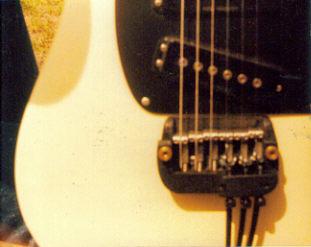
 |
|
|
 |
Danny James
From:
Summerfield Florida USA
|
 Posted 26 Jun 2011 11:11 am
Posted 26 Jun 2011 11:11 am |
|
Alan,
With the tunings Harlin's used with their Multi-Kords we did release one pedal and depress another throughout a song while being played. Sometimes we depressed two pedals at the same time. I do this with the song "Silent Night" in one place.
Example when I play the song Harbor Lights, I use four different tunings throughout the song. A, A6th, D7added 9th, and C#mi.7th. I do this in order to play the harmony notes that go with the melody note and the chord that goes with it in two to 6 string combinations. |
|
|
 |
Danny James
From:
Summerfield Florida USA
|
 Posted 26 Jun 2011 11:24 am
Posted 26 Jun 2011 11:24 am |
|
Alan,
Check your e-mail.
Danny |
|
|
 |
William Johnson
From:
Statesboro, Georgia, USA
|
 Posted 27 Jun 2011 7:44 am Electric servo-stepping motor controlled PSG in the future?
Posted 27 Jun 2011 7:44 am Electric servo-stepping motor controlled PSG in the future? |
|
Someone will come up with a servo-stepping motor control for pedal steels. You could program-in feel, etc. With this technology you would have NO visible cables, be much-much lighter, accurate and repeatable, and maybe less expensive to build, but would have to be plugged in electrical power source such as 120VAC outlet, batteries, phantom power (-48VDC) or maybe a 'beefed-up' USB connection! It could be done without a doubt if $$ allows.
What do you think?
_________________
William Johnson (Billy)
Statesboro, GA
Sho Bud Student / Emmons DB E9
Sierra DB E9 / ZUM DB E9 / Derby DB E9 Marlen E9 / BMI E9
Mosrite Ventures '69 / Gibson Cherry ES345 / Custom 'Billie-Tele' Telecaster / Gibson '78 J45 / Custom 'P-Strat' Squire Stratocaster / Epi Parlor
Fender '69 Deluxe Reverb / Peavey NV400 + Peavey TubeFex + Goodrich 7A MatchBox & Pedal |
|
|
 |
Alan Brookes
From:
Brummy living in Southern California
|
 Posted 28 Jun 2011 10:44 am Re: Electric servo-stepping motor controlled PSG in the futu
Posted 28 Jun 2011 10:44 am Re: Electric servo-stepping motor controlled PSG in the futu |
|
| William Johnson wrote: |
| Someone will come up with a servo-stepping motor control for pedal steels... |
This suggestion was discussed in detail on the Forum about two years ago. I searched for the thread so that we could ressurect it, but I couldn't find it. It was about the time Gibson came out with their automatic-tuning acoustic guitar. One of the problems I can see straight away is the speed of the change. For instance, there are some numbers where I depress the pedals very slowly, while others where I press them very quickly. You would need something like the zoom control on a camera. |
|
|
 |
Danny James
From:
Summerfield Florida USA
|
 Posted 29 Jun 2011 5:17 am
Posted 29 Jun 2011 5:17 am |
|
It might be possible to add feel and variations of how fast one depresses a pedal, using servos.
Example my son and I used to fly radio controlled model airplanes. Some as big as 1/3 scale powered by weed eater engines. The throttle, elevator, rudder, ailerons, & retractable landing gear, were all controlled by servos, which were radio controlled by a hand held unit with joy sticks. How far and fast you moved the joy sticks created an instant and equal response at the aircraft.
With powerful enough servos I think this principal could be applied to a steel guitar. The Military obviously is using them in their radio controlled drones these days. So powerful servos should be available.
Back to your Multi-Kord projects, Best of luck.  |
|
|
 |
William Johnson
From:
Statesboro, Georgia, USA
|
 Posted 29 Jun 2011 10:31 am
Posted 29 Jun 2011 10:31 am |
|
Yea, there would be a way to monitor your foot/knee speed and force, etc. and simulate a desired PSG pedal 'feel'.via closed feedback loop.
billy
_________________
William Johnson (Billy)
Statesboro, GA
Sho Bud Student / Emmons DB E9
Sierra DB E9 / ZUM DB E9 / Derby DB E9 Marlen E9 / BMI E9
Mosrite Ventures '69 / Gibson Cherry ES345 / Custom 'Billie-Tele' Telecaster / Gibson '78 J45 / Custom 'P-Strat' Squire Stratocaster / Epi Parlor
Fender '69 Deluxe Reverb / Peavey NV400 + Peavey TubeFex + Goodrich 7A MatchBox & Pedal |
|
|
 |
Alan Brookes
From:
Brummy living in Southern California
|
 Posted 10 Jul 2014 3:25 pm
Posted 10 Jul 2014 3:25 pm |
|
| Has anyone progressed with this concept since the last posting? |
|
|
 |
Ian Worley
From:
Sacramento, CA
|
 Posted 10 Jul 2014 10:32 pm Re: Electric servo-stepping motor controlled PSG in the futu
Posted 10 Jul 2014 10:32 pm Re: Electric servo-stepping motor controlled PSG in the futu |
|
| William Johnson wrote: |
| Someone will come up with a servo-stepping motor control for pedal steels |
I just read about someone who had done this on a tele, sort of a remote controlled futurama Parsons-White contraption. There's a description and video here:
http://www.gizmag.com/tele-servo-bender/32915/
He's even posted the code for the control software in case someone is looking for a new psg project... |
|
|
 |
Les Cargill
From:
Oklahoma City, Ok, USA
|
|
|
 |




